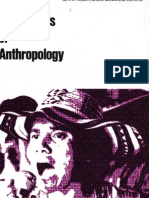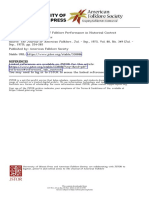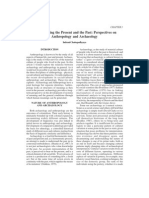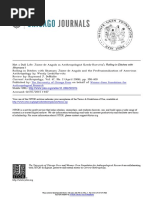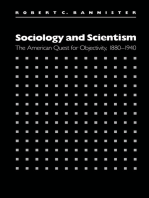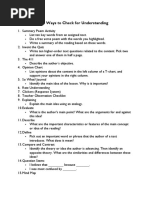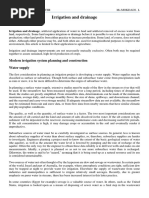0 ratings0% found this document useful (0 votes)
29 viewsCrashing Thunder. Research On Life
Crashing Thunder. Research On Life
Uploaded by
hafiThis document discusses different types of historical research done by social anthropologists. It begins by describing life histories and biographies of individuals from other cultures, which were some of the earliest forms of historical research. It then discusses how collecting biographies can provide time depth to studies through extended case studies and developmental cycle methods. The document also covers ethnohistorical research that combines fieldwork with analysis of documentary records, as well as historical ethnographies that reconstruct past cultures. Overall, the document outlines a variety of qualitative historical research approaches used in social anthropology.
Copyright:
© All Rights Reserved
Available Formats
Download as DOCX, PDF, TXT or read online from Scribd
Crashing Thunder. Research On Life
Crashing Thunder. Research On Life
Uploaded by
hafi0 ratings0% found this document useful (0 votes)
29 views3 pagesThis document discusses different types of historical research done by social anthropologists. It begins by describing life histories and biographies of individuals from other cultures, which were some of the earliest forms of historical research. It then discusses how collecting biographies can provide time depth to studies through extended case studies and developmental cycle methods. The document also covers ethnohistorical research that combines fieldwork with analysis of documentary records, as well as historical ethnographies that reconstruct past cultures. Overall, the document outlines a variety of qualitative historical research approaches used in social anthropology.
Original Description:
nugas
Original Title
Tugas Adit
Copyright
© © All Rights Reserved
Available Formats
DOCX, PDF, TXT or read online from Scribd
Share this document
Did you find this document useful?
Is this content inappropriate?
This document discusses different types of historical research done by social anthropologists. It begins by describing life histories and biographies of individuals from other cultures, which were some of the earliest forms of historical research. It then discusses how collecting biographies can provide time depth to studies through extended case studies and developmental cycle methods. The document also covers ethnohistorical research that combines fieldwork with analysis of documentary records, as well as historical ethnographies that reconstruct past cultures. Overall, the document outlines a variety of qualitative historical research approaches used in social anthropology.
Copyright:
© All Rights Reserved
Available Formats
Download as DOCX, PDF, TXT or read online from Scribd
Download as docx, pdf, or txt
0 ratings0% found this document useful (0 votes)
29 views3 pagesCrashing Thunder. Research On Life
Crashing Thunder. Research On Life
Uploaded by
hafiThis document discusses different types of historical research done by social anthropologists. It begins by describing life histories and biographies of individuals from other cultures, which were some of the earliest forms of historical research. It then discusses how collecting biographies can provide time depth to studies through extended case studies and developmental cycle methods. The document also covers ethnohistorical research that combines fieldwork with analysis of documentary records, as well as historical ethnographies that reconstruct past cultures. Overall, the document outlines a variety of qualitative historical research approaches used in social anthropology.
Copyright:
© All Rights Reserved
Available Formats
Download as DOCX, PDF, TXT or read online from Scribd
Download as docx, pdf, or txt
You are on page 1of 3
Types of Research among American anthropologists,
though they called them life
Contemporary social
histories. This interest was
antropologists are doing a variety
aroused in 1926 with the
of types of historical research,
publication of Paul Radins
some similar to the kinds of
Crashing Thunder. Research on life
research that historians do and
histories did not become popular,
others dictated by traditional
however, until the 1930s and
interest of social anthropology. In
1940s, through the influence of
reviewing research in this area, one
Edward Sapir and ClydeKluckhohn ;
can separate the work of social
and perhaps as a result of their
anthropologists from that of
influence life histories were
historians and scholars in other
distinctly psychological in pointof
fields only in the most arbitrary
view. In recent years, however, a
fashion. And rather than do this it
number of excellent bioghraphies
has seemed wiser to include some
of people in other cultures have
work by nonanthropologists.
been published which are not at all
Life Histories. Biographies of historical. One need only mention
individuals in exotic societies Oscar Lewis The Children of
probably constitute the most Sanchez (1961) and Pedro Martinez
concrete and obvious kind of (1964) and Theodora Kroebers
historical research in social incomparable Ishi (1961). In
anthropology. There were, of addition to being a legitimate and
course, many examples of this kind useful means of documenting life in
of bioghrapy before anthropology other cultures from an individual
existed in a formal sense. Many perspective, the biographical form
biographies of American Indians is an effective means of
were written in the nineteenth communicating to the layman what
century, most of them coming out anthropology has to teach.
at about the same time that the
Biographies and Tme Depth.
last remaining American Indians
Collecting biographies can also be
lost their autonomy (Langness
used as a research technique in
1965:5-7). Most of these
anthropological fieldwork (Lagness
biographies have been ignored by
1965:20-46), and is particularly
anthropologists, quite unjustly, on
useful in fieldwork that attempts to
the grounds that they are too
add time depth to a synchronic
literary.
study. There are two principal ways
The writing of biographies of doing this: the extended case
enjoyed a brief period of popularity method and the developmental
cycle method (Olien 1967). In the particulary useful in working out
extended case method, the complicated variables governing
fieldworker follows a single set of succession to office in tribal
persons throught time, using the societies (I. M. Lewis, ed., 1968:xvi-
incidents in which they become xvii). In tribal politics and in many
involved as a means of clarifying other areas of social life it is
the relationships among them. The becoming apparent that a flat,
fieldworker observes the behavior synchronic analysis misses much.
of the group of persons over an For example, in the light of a purely
extended period of time, collects synchronic study a social institution
their oral accounts of events in the might appear to be defunct, only to
past, and consults any written appear later in changed social
records that may be available conditions as a fully viable social
(Mitchell 1956, Gluckman 1961). In form. An example of just this kind
the developmental cycle method, of thing has been found by E.R.
the interest is in the statistical Cregeen (1968) in his historical
properties of groups that have a study of Scottish clanship. In light
life cycle, a regular course of of this, we see that Durkheims
development (Fortes 1949, Goody realization of the value of historical
1958). When the developmental research in sociological studies was
cycle method is used, it often turns especially prophetic.
out that seemingly different types
Ethnohistory. Ethnohistory, or
of domestic groups are simply
historical ethnology, bases its
different stages of a single
research primarily on the study of
structure that changes through
documentary information. There
time. In both of these methods
are as many varieties of historical
biographical information is quite
ethnology as there are kinds if
useful. The two methods can be
history. Following the precedent of
combined in the same piece of
historians, social anthropologists
research, as was done by John
produce critical editions of primary
Middleton in his Lugbara Religion
historical documents, which, thus
(1960).
edited, become accessible to the
Fieldwork and Documentary general reader and more useful to
Data. These firsthand field studies the scholar. Examples are John
that incorporate time depth shade C.Ewers edition (1967) of George
imperceptibly into studies that Catlins O-kee-pa, a Mandan
combine field data with religious ceremony Catlin
documentary data. The use of witnessed in 1832, and his edition
documentary records has been of Jean Louis Berlandiers (1969)
description of Indians in Texas in economics (Obeysekere 1967), and
1830. A long this same line are belief system (Leon-Portilla 1963).
critical editions of documents by
As historical equivalents of
literate members of exotic cultures,
traditional, holistic ethnographies,
such as Leon-Portillas (1962)
many fine historical ethnographies
version of the Aztec account of the
of societies in most of the major
conquest of Mexico and James
areas of the world have been
Mooney and Frans Olbrechts
produced by anthropologists in
(1932) version of the Swimmer
recent years. Selecting a few
manuscript, a notebook written by
arbitrarily, for Africa we have
a Cherokee medicine man in the
Argyles (1966) work on the Fon of
Sequoyah syllbary.
Dahomey and Alagoas (1964)
The Kinds of research done history of the nembe people of the
by historical ethnologists is similar Niger Delta. For North America we
to anthropologists analyses of have Hickersons (1962,1970) work
their field data on particular social on the Chippewa, Tookers (1964)
institutions or aspects of culture. ethnography of the early
Any selection from the works in this seventeenth-century Huron
category is bound to be arbitrary. Indians, and Welthfishs (1965)
One can mention Lancaster' reconstruction of a year in the life
(1958) study of the bilateral kinship of the Pawnee Indians. For Latin
system of the Anglo-Saxons and America we have Ronald Spores
Maurice Freedmans (1958) study book on the Mixtec of northwestern
of lineage organization in China. Oaxaca in Mexico, derived from
Nor is kinship the only subject of archaeological, ethnographic, and
interest to historical ethnologists. historical sources.
There have been historical studies
One further topic on which
of political organization (Evans-
Pritchard 1949,M. G. Smith 1960),
You might also like
- Car Rental InvoiceDocument1 pageCar Rental InvoiceAnshul Kumar Garg0% (2)
- The Rise of Anthropological Theory A History of Theories of Culture by Marvin HarrisDocument816 pagesThe Rise of Anthropological Theory A History of Theories of Culture by Marvin HarrisBAJOANGOSTONo ratings yet
- Asad Talal - Anthropology and The Colonial Encounter - en Gerrit Huizer y Bruce Manheim - The Politics of AnthropologyDocument14 pagesAsad Talal - Anthropology and The Colonial Encounter - en Gerrit Huizer y Bruce Manheim - The Politics of Anthropologypangea2885No ratings yet
- A Model For The Analysis of Folklore Performance in Historical ContextDocument13 pagesA Model For The Analysis of Folklore Performance in Historical ContextAna Savić100% (1)
- (History of Anthropology) George W. Stocking Jr. - Observers Observed - Essays On Ethnographic Fieldwork-University of Wisconsin Press (1985) PDFDocument250 pages(History of Anthropology) George W. Stocking Jr. - Observers Observed - Essays On Ethnographic Fieldwork-University of Wisconsin Press (1985) PDFHermes De Sousa VerasNo ratings yet
- Observers Observed Essays On E George W Stocking JR PDFDocument248 pagesObservers Observed Essays On E George W Stocking JR PDFPriscilaTavares100% (1)
- Metal Expansion Joints by KE-BurgmannDocument16 pagesMetal Expansion Joints by KE-BurgmannEJSKAT50% (2)
- Observers Observed - Essays On E - George W. Stocking JRDocument248 pagesObservers Observed - Essays On E - George W. Stocking JRmajorbonobo100% (4)
- Observers Observed Essays On E George W Stocking JRDocument265 pagesObservers Observed Essays On E George W Stocking JROrlando HöfkeNo ratings yet
- Antropological History of Senses. HowesDocument10 pagesAntropological History of Senses. HowesCristián Olivares AcuñaNo ratings yet
- Little 2009 - A Breif Overview of History Antropology and HA en EEUUDocument20 pagesLittle 2009 - A Breif Overview of History Antropology and HA en EEUUMaría GabrielaNo ratings yet
- Functionalism Historicized - Ess - George W. Stocking JR - PDFDocument252 pagesFunctionalism Historicized - Ess - George W. Stocking JR - PDFmajorbonobo100% (4)
- (History of Anthropology) George W. Stocking Jr.-Romantic Motives - Essays On Anthropological Sensibility-University of Wisconsin Press (1996)Document296 pages(History of Anthropology) George W. Stocking Jr.-Romantic Motives - Essays On Anthropological Sensibility-University of Wisconsin Press (1996)Debora S. LonderoNo ratings yet
- Anth SI 03 3 Chattopadhyaya I TTDocument6 pagesAnth SI 03 3 Chattopadhyaya I TTshykyoichiNo ratings yet
- Bunzl2005 PDFDocument9 pagesBunzl2005 PDFwajahatNo ratings yet
- (History of Anthropology) George W. Stocking Jr.-Colonial Situations - Essays On The Contextualization of Ethnographic Knowledge-University of Wisconsin Press (1993)Document350 pages(History of Anthropology) George W. Stocking Jr.-Colonial Situations - Essays On The Contextualization of Ethnographic Knowledge-University of Wisconsin Press (1993)Betina Peppina100% (1)
- Bragdon 2018 Indigenous TheoryDocument4 pagesBragdon 2018 Indigenous TheoryLarkin McBrideNo ratings yet
- Jack Goody. What Does Anthropology Contribute To World History?Document16 pagesJack Goody. What Does Anthropology Contribute To World History?Henrique Espada LimaNo ratings yet
- Kemper-Rollwagen - Urban - Anthropology - Encyclopedia - of - Cultural Anthropology PDFDocument10 pagesKemper-Rollwagen - Urban - Anthropology - Encyclopedia - of - Cultural Anthropology PDFM PNo ratings yet
- Anna Green ReviewDocument3 pagesAnna Green ReviewMarco Alvarez ZuñigaNo ratings yet
- Introduction Analysing Personal NarrativDocument38 pagesIntroduction Analysing Personal NarrativBougleux Bomjardim Da Silva CarmoNo ratings yet
- Price Sally - Art Anthropology and Museums. Post Colonial Directions in The USADocument14 pagesPrice Sally - Art Anthropology and Museums. Post Colonial Directions in The USASantiago ZapataNo ratings yet
- INOFRE Jennifer D. FS101 Contributions of Renowned Anthropologists Archaeologists Ethnologists HistoriansDocument10 pagesINOFRE Jennifer D. FS101 Contributions of Renowned Anthropologists Archaeologists Ethnologists HistoriansKaren PidotNo ratings yet
- Chapman 2003 - Social Dimensions Mortuary PracticesDocument9 pagesChapman 2003 - Social Dimensions Mortuary PracticesDaniela GrimbergNo ratings yet
- Social Anthro and Social HistDocument16 pagesSocial Anthro and Social HistjedicalleNo ratings yet
- Asad, TalalDocument295 pagesAsad, TalalFuiryNo ratings yet
- Folklore in The Midst of Social ChangeDocument30 pagesFolklore in The Midst of Social Changerelativity3.14No ratings yet
- Anna Green ReviewDocument5 pagesAnna Green ReviewMiguel Angel ChchamavNo ratings yet
- Anthro N HistoryDocument5 pagesAnthro N HistoryXiaofeng DaiNo ratings yet
- This Content Downloaded From 103.96.104.218 On Fri, 24 Jul 2020 22:15:03 UTCDocument9 pagesThis Content Downloaded From 103.96.104.218 On Fri, 24 Jul 2020 22:15:03 UTCAbantee HarunNo ratings yet
- Antropology Why Intrest in MediaDocument7 pagesAntropology Why Intrest in Mediachristopher templarNo ratings yet
- Anthro. Lecture Notech 1-4Document212 pagesAnthro. Lecture Notech 1-4letitolesa472No ratings yet
- Ethnography as a Colonial Practice 1994Document34 pagesEthnography as a Colonial Practice 1994giuliadiemmeNo ratings yet
- ELK Articulating Comprehensive Frameworks On Socio-Cultural Change Sujay Rao MandavilliDocument104 pagesELK Articulating Comprehensive Frameworks On Socio-Cultural Change Sujay Rao MandavilliSujay Rao MandavilliNo ratings yet
- Between Community and The Other: Notes of Cultural AnthropologyDocument6 pagesBetween Community and The Other: Notes of Cultural AnthropologyMichele Filippo FontefrancescoNo ratings yet
- Shamans: The University of Chicago Press Wenner-Gren Foundation For Anthropological ResearchDocument4 pagesShamans: The University of Chicago Press Wenner-Gren Foundation For Anthropological ResearchEu mesmoNo ratings yet
- Colonial Situations - Essays On - George W. Stocking JR - PDFDocument348 pagesColonial Situations - Essays On - George W. Stocking JR - PDFmajorbonobo100% (4)
- Social Anthropology Is The Dominant Constituent of Anthropology Throughout The United Kingdom and Commonwealth and Much of EuropeDocument9 pagesSocial Anthropology Is The Dominant Constituent of Anthropology Throughout The United Kingdom and Commonwealth and Much of EuropesnehaoctNo ratings yet
- Franz Boas: Ruth Benedict, Née Ruth Fulton, (Born June 5, 1887, New York, N.Y., U.SDocument6 pagesFranz Boas: Ruth Benedict, Née Ruth Fulton, (Born June 5, 1887, New York, N.Y., U.SjhanelleNo ratings yet
- Anthropological Field Researches in The 21 Century: Scope, Challenges and EthicsDocument12 pagesAnthropological Field Researches in The 21 Century: Scope, Challenges and EthicsaanakorathNo ratings yet
- Andre Beteille On TribesDocument23 pagesAndre Beteille On TribesramyanisanyalNo ratings yet
- Approaches To HistoryDocument90 pagesApproaches To Historysanazh100% (2)
- History and Society - Problems of Interpretation - D.D. KosambiDocument225 pagesHistory and Society - Problems of Interpretation - D.D. KosambiScarlettNyxNo ratings yet
- Chapter 1 Anthropology and Human DiversityDocument8 pagesChapter 1 Anthropology and Human DiversityRachelNo ratings yet
- Aula 2 - Anthropology and The Colonial Encounter - Talal AsadDocument11 pagesAula 2 - Anthropology and The Colonial Encounter - Talal AsadPatrinieri LuNo ratings yet
- Urbanism, Urbanization and AcculturationDocument10 pagesUrbanism, Urbanization and Acculturationvacamulticolor2001No ratings yet
- Stocking George W Ed Romantic Motives Essays On Anthropologi PDFDocument296 pagesStocking George W Ed Romantic Motives Essays On Anthropologi PDFОльга ЖолудьNo ratings yet
- Approach Types of HistoryDocument18 pagesApproach Types of HistoryAhmad Khalilul Hameedy NordinNo ratings yet
- D'ANDRADE, Roy. The Sad Story of Anthropology 1950-1999Document15 pagesD'ANDRADE, Roy. The Sad Story of Anthropology 1950-1999jeansegataNo ratings yet
- Prehistoric Europeans' in Xinjiang? A Case For Multiple InterpretationsDocument19 pagesPrehistoric Europeans' in Xinjiang? A Case For Multiple Interpretationsgangchen_gonpoNo ratings yet
- Day 3Document37 pagesDay 3John Briane CapiliNo ratings yet
- Cultural Anthropology Is A Branch Of: Edward Burnett TylorDocument7 pagesCultural Anthropology Is A Branch Of: Edward Burnett TylorChristian ConsignaNo ratings yet
- 01 REQUIRED Asad - Introduction - Anthropology and The Colonial EncounterDocument15 pages01 REQUIRED Asad - Introduction - Anthropology and The Colonial EncounterAhmad AlaqqadNo ratings yet
- Historical Anthropology Comprehensive ExamDocument14 pagesHistorical Anthropology Comprehensive ExamBryce PeakeNo ratings yet
- Anthropology, History Of: Thomas H Eriksen, University of Oslo, Oslo, NorwayDocument7 pagesAnthropology, History Of: Thomas H Eriksen, University of Oslo, Oslo, NorwayRanjan Kumar SinghNo ratings yet
- Archaeology, Anthropology, and The Culture ConceptDocument13 pagesArchaeology, Anthropology, and The Culture ConceptAlberto José CampilloNo ratings yet
- (The American Ethnological Society, Monograph 43) June Helm, Jacob Gruber, Nancy Oestreich Lurie, Ross Parmenter, Ronald P. Rohner - Pioneers of American Anthropology - The UsDocument280 pages(The American Ethnological Society, Monograph 43) June Helm, Jacob Gruber, Nancy Oestreich Lurie, Ross Parmenter, Ronald P. Rohner - Pioneers of American Anthropology - The UsAnonymous yh6gcTCjP4No ratings yet
- Lewis - in Defense of Anthropology - 2014 PDFDocument18 pagesLewis - in Defense of Anthropology - 2014 PDFJorge Iván VergaraNo ratings yet
- Melko M. - The Nature of CivilizationsDocument10 pagesMelko M. - The Nature of CivilizationsRafa Actis CaporaleNo ratings yet
- After Society: Anthropological Trajectories out of OxfordFrom EverandAfter Society: Anthropological Trajectories out of OxfordJoão Pina-CabralNo ratings yet
- Sociology and Scientism: The American Quest for Objectivity, 1880-1940From EverandSociology and Scientism: The American Quest for Objectivity, 1880-1940No ratings yet
- Towards an Operational Social Anthropology: Volume 1: An Epistemological History of Social AnthropologyFrom EverandTowards an Operational Social Anthropology: Volume 1: An Epistemological History of Social AnthropologyNo ratings yet
- Farfis KurvaDocument8 pagesFarfis KurvahafiNo ratings yet
- FarfisDocument2 pagesFarfishafiNo ratings yet
- Daftar Absen Training FutsalDocument2 pagesDaftar Absen Training FutsalhafiNo ratings yet
- Slime Moulds TugasDocument4 pagesSlime Moulds TugashafiNo ratings yet
- In The Supreme Court of India: Appreciation of History/customs/essentiality During AdjudicationDocument7 pagesIn The Supreme Court of India: Appreciation of History/customs/essentiality During Adjudicationichchhit srivastavaNo ratings yet
- PremiumDocument1 pagePremiumChandan Kumar JhaNo ratings yet
- Queen Interview 01-19-1978 "Circus Magazine"Document4 pagesQueen Interview 01-19-1978 "Circus Magazine"SunnyNo ratings yet
- Lumayna vs. COADocument11 pagesLumayna vs. COASarah Beth TomasNo ratings yet
- Lesson Plan #2: Collaboration: Grade: 2 Social Studies Strand: GeographyDocument5 pagesLesson Plan #2: Collaboration: Grade: 2 Social Studies Strand: Geographyvidareljic22100% (1)
- RBFoote M&E Pappu - RBFDocument21 pagesRBFoote M&E Pappu - RBFInsane ReaderNo ratings yet
- National Climate Assessment - Forest Sector Technical ReportDocument623 pagesNational Climate Assessment - Forest Sector Technical ReportmizzakeeNo ratings yet
- ABECEDARIO Alphabet Mobiles Lower Case US RAINBOW VALLEYDocument20 pagesABECEDARIO Alphabet Mobiles Lower Case US RAINBOW VALLEYLumiere Crochet100% (1)
- Jyothsna ReportDocument109 pagesJyothsna ReportThalapathy Ra UngammaNo ratings yet
- Topik 9 SimDocument20 pagesTopik 9 SimerzaNo ratings yet
- SparkDocument3 pagesSparkManjeet AhujaNo ratings yet
- Recommender MidTerm - 2Document12 pagesRecommender MidTerm - 2bjananika17No ratings yet
- Download full The Court and Court Society in Ancient Monarchies 1st Edition A. J. S. Spawforth ebook all chaptersDocument60 pagesDownload full The Court and Court Society in Ancient Monarchies 1st Edition A. J. S. Spawforth ebook all chapterstaraseymervm100% (6)
- 53 Ways To Check UnderstandingDocument4 pages53 Ways To Check UnderstandingJoshuaNo ratings yet
- Raja Yoga Swami Vivekananda OdiaDocument183 pagesRaja Yoga Swami Vivekananda Odiamukti123No ratings yet
- Kapayapaan Integrated School SY: - Dressmaking/Tailoring Tle-8 Summative Test SY-2019-2020Document3 pagesKapayapaan Integrated School SY: - Dressmaking/Tailoring Tle-8 Summative Test SY-2019-2020maria cristina pascual100% (1)
- Manila Electric CompanyDocument23 pagesManila Electric CompanyIrishNo ratings yet
- Activity 2 NSTPDocument7 pagesActivity 2 NSTPJynelle CabacunganNo ratings yet
- ElectricityDocument8 pagesElectricitySeetha Lekshmi KishoreNo ratings yet
- WInS Checklist School Based 2023Document9 pagesWInS Checklist School Based 2023Jhay TangcoNo ratings yet
- OceanofPDF - Com Call Me Yours - Megs HudsonDocument207 pagesOceanofPDF - Com Call Me Yours - Megs HudsonradzilaniriliseNo ratings yet
- 4ème Cours - Irrigation and DrainageDocument4 pages4ème Cours - Irrigation and DrainageBroomNo ratings yet
- Washing Machine Owner's InstructionsDocument24 pagesWashing Machine Owner's InstructionspocepokeNo ratings yet
- Topic:-Memorandum of Association & Articles of Association: IndexDocument11 pagesTopic:-Memorandum of Association & Articles of Association: IndexBrajesh SinghNo ratings yet
- Soft Power With Chinese Characteristics: The Ongoing DebateDocument17 pagesSoft Power With Chinese Characteristics: The Ongoing DebateKanka kNo ratings yet
- HTRTW Syllabus Revised 1031Document6 pagesHTRTW Syllabus Revised 1031JozephyrsNo ratings yet
- ABRSM Cello RequirementsDocument3 pagesABRSM Cello RequirementsENo ratings yet
- An Essay On NewspaperDocument4 pagesAn Essay On NewspaperjwpihacafNo ratings yet


